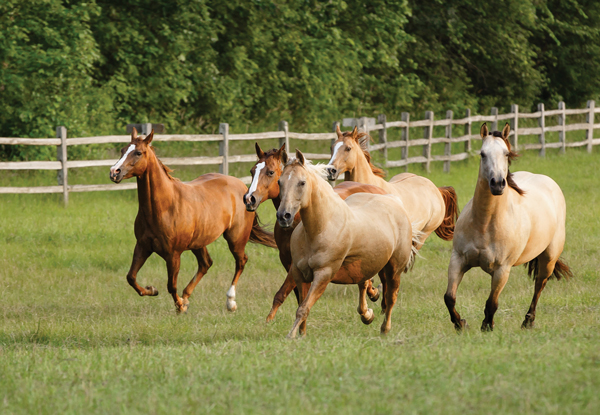
If you’ve ever kept a horse on pasture full-time, you may have noticed he’s calmer and more relaxed to ride than when kept in a stall, and his muscles stay fitter and looser from moving around all day. Although there may be occasional nicks and scratches from playful herd mates to contend with, many horse owners feel the trade-off is well worthwhile. Here are some strategies you can you use to improve safety while still allowing horses to live naturally in a group. Risk management for pastured horses is an important topic for horse owners, whether you have horses at home or pasture board.
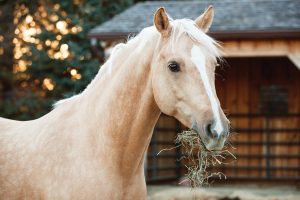
Safer Pastures for Horses
◆ Gate bolts that stick out should be cut flush with the post.
◆ Protective caps should be applied on the top of T-posts if using electric fencing.
◆ Use reliable clips and latches that horses can’t undo to escape.
◆ If your property already has fencing in place that isn’t particularly horse-safe, like barbed wire, smooth wire strand, thick cable material, or rickety wood posts or planks, it’s a good idea to install electric fencing on the inside of the perimeter to discourage horses from getting too close to the fence line and being injured.
◆ Make sure there is plenty of room for a large group of horses to be able to get away from each other. Horses need room to move away from a more dominant herd member.
◆ Check that the fence line doesn’t create areas where a horse could become trapped.
◆ Make sure there are at least two entrances/exits in loafing sheds so a horse can’t get pinned in a corner.
◆ A loafing shed should be large enough to accommodate as many horses as want to shelter from inclement weather, or make sure you provide a sufficient number of sheds in difficult climates.
◆ On the interior of the paddock, remove or fence out hazards, like culverts, ditches, ponds or dangerous waterways, farm equipment, downed wire, roofing or shed materials, poisonous trees (such as maple and Russian olive) or fruit-bearing trees.
Look at everything with a critical eye for the possibility of injury. Preventive maintenance prevents vet bills! Eliminate any hazards that could cause an avoidable accident.
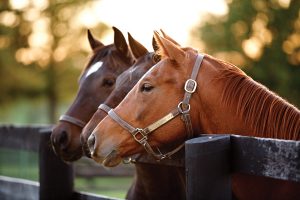
Putting Horses Together
It might seem that because horses are social animals, they can just be turned out together right away. But that isn’t always the best approach.
There are a number of strategies to help ease territorial disputes. Some of these suggestions take a while to put into play, but taking the appropriate amount of time is a better way to reduce the risk of injury.
Separate social groups into geldings with geldings or mares with mares. This cuts down on rivalries and dynamics of mare versus gelding behavior, or spats caused by protective behavior between genders, especially with mares in heat.
Specific age groups do better when grouped together, too: weanlings with weanlings, yearlings with yearlings, and seniors with seniors, for example.
Making Introductions
One of the most important tips for risk management in pastured horses is to set up an area where new horses can meet herd members over the fence in a “welcome pen” for seven to 10 days before they are completely together.
You’ll want to separate a horse that is new to the property for two to three weeks prior to ensure he’s not incubating an infectious disease. Once the horse has passed that timeline and is obviously healthy, then the meet-over-a- safe-fence tactic can begin. Confrontations of charging and kicking may occur over food, so for a new horse in a small enclosure, place the feeding area as far from the fence as possible.
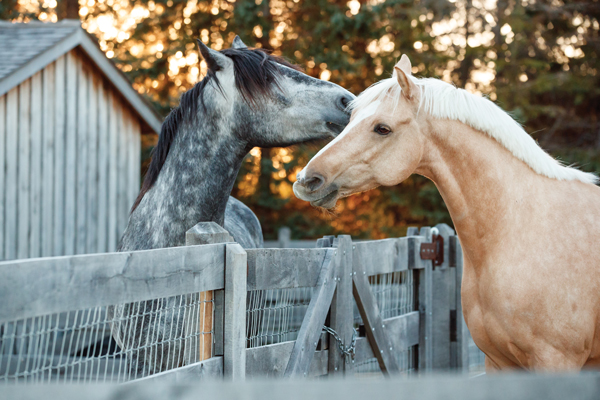
Based on which herd members visit the new horse and how they appear to get along over the fence, pick a seemingly compatible herd member and turn that individual out with the new horse in a paddock or field separate from the herd. This allows them to buddy up a bit so when the new horse is introduced to the entire herd, the original herd member eases the new horse into acceptance by the others.
Before putting him in a new environment, walk the new horse along the fence line in both directions to show him the limits of his new universe. Show him any hazards that can’t be removed or fenced out.
Horses need to see everything with both eyes for it to really to stick in their minds. Circle everything clockwise and counter-clockwise, letting him ook and smell as you make the rounds. Then he won’t be surprised by sudden physical encounters of landscape or fencing when running and playing in that enclosure.
When turning a new horse out into a herd for the first time, monitor their interactions those first few days so you can step in and break up any trouble. Horses that tend to be disruptive or cause repeated injuries to others should be removed from the herd and housed separately or with other compatible horses.
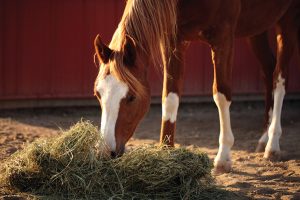
Feeding times can be fraught with disputes and aggressive behavior in otherwise tractable horses. Make sure there are sufficient feeding stations and hay piles spread far enough apart so that bully horses can’t shove a less dominant horse away from food.
Older horses generally do better when grouped with similarly aged herd members since they often eat more slowly. It’s important that food is still available if they wander off before finishing, which isn’t likely to be the case if senior horses are pastured with younger ones.
Risk Management for Pastured Horses Includes Herd Immunity
Another important feature of horses being in a herd is to minimize the risk of infectious disease. Immunization against infectious disease on a regular schedule of most, if not all, herd members helps to optimize herd immunity. This preventive practice is important not just for horses that travel off the farm for shows and clinics, but also for resident horses that remain in place.
Letting horses be horses by giving them the opportunity to live in a herd is one of the best management tools you can provide for your horse’s well-being. Taking precautions to ensure safety and limit risk of injury by thinking about risk management for pastured horses makes this strategy work. Your horse will feel better both mentally and physically and will perform better, giving you a more enjoyable partnership in your equestrian adventures.
This article on the risk management for pastured horses originally appeared in the September 2019 issue of Horse Illustrated magazine. Click here to subscribe!
Further Reading






Really love this article. Leading the new horse around the new enclosure, both clockwise and counter clockwise is a must! Whether or not the horse is by itself, or turned into an area with only one other horse, or multiple horses, it needs to see all the area from both directions… Remember the ‘right brain, left brain’ training lessons from the clinicians?
Keeping both/all of the horses safe is of the utmost priority. Putting an electric wire on the top of the dividing fences is a good idea. Some dominant horses will charge even the ’round corral’ panels, to show the new horse who’s boss! One sting from the electric wire or tape, will prevent fence, and horse damage, and turn that full on charge in to a very visual ear flattening, and an occasional audible hiss! ( I HATE you! This is MINE! Stay away! )
Love the Horse Illustrated articles. Great for beginners and experienced horse people, of all levels! Now, Lets enjoy our horses!